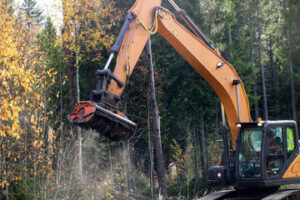Drain Cleaning is the process of removing organic materials, bacteria, and germs that lead to foul smells and clogged pipes. It is important to perform this routinely, especially in the kitchen and bathroom.

Fortunately, there are many effective methods for cleaning your drains without using harsh chemicals. This includes the use of baking soda and vinegar, caustic drain cleaners, or enzyme drain cleaners. Contact Drain Cleaning Sarasota for professional help.
Keeping your drains clean can help prevent clogs and foul smells. Many household items, such as hair, grease, and soap scum can get stuck inside of pipes. These materials can also block the flow of water, causing sewage back-ups and other serious problems. To keep your drains in good condition, make sure to regularly perform certain maintenance tasks.
One of the most effective ways to keep your drains smelling fresh and clean is to use a baking soda and vinegar mixture. This solution is non-toxic and effectively dissolves organic materials that cause bad odors. To use this natural cleaner, mix equal parts of baking soda and vinegar, pour it down the drain, wait 30 minutes to an hour, then rinse with hot water. This simple technique can be performed at least once a week to keep your drains smelling fresh and free from debris that can cause clogs.
Another way to keep your drains clean is to periodically flush them with boiling water. This method can be used in conjunction with a plunger or snake to loosen any food particles or other substances that may be causing a clog. The hot water will also melt any grease deposits that have collected in your drains.
If you are using a chemical drain cleaner, it is important to follow the instructions carefully. Many of these products contain corrosive ingredients that can damage your pipes and cause other health hazards. Instead, try using a more natural drain cleaning solution, such as an enzyme cleaner that uses bacteria to break down organic waste in your pipes.
It is also important to wear proper safety equipment when performing manual drain cleaning. Wearing a pair of durable gloves and protective eyewear can prevent contact with biological and chemical contaminants. Hearing protection like earplugs or a face mask is also recommended to protect against exposure to fumes and aerosols. Finally, you should always dispose of chemicals properly to prevent environmental pollution. Chemicals that wash down the drain can seep into groundwater and pollute sources of drinking water. The best way to protect the environment is to use non-toxic alternatives for drain cleaning.
Eliminating Bad Odors
Foul odors can be caused by the buildup of waste in drains, resulting in clogs that emit foul gases. This is why it’s important to clean your drains regularly to eliminate these odors and prevent future problems.
Professional drain cleaning services use advanced tools and techniques that can help identify the source of the odors and fix the problem at its root. These services also include video inspection equipment that allows the plumber to see the inside of your pipes and identify any damage or blockages.
A professional can recommend the best drain cleaner for your home based on the type of clog and your environmental preferences. Chemical cleaners provide quick results but can corrode metal pipes and cause toxic fumes, while enzymatic cleaners are eco-friendly and safe for all pipe types. Mechanical tools are also useful for tackling stubborn clogs that chemical cleaners can’t break up on their own.
If you have a minor clog that’s emitting a bad smell, try pouring boiling water down the drain. This will dissolve grease and wash away food particles that could be contributing to the odor. You can also pour baking soda and vinegar down a drain to clear up odors and promote bacterial growth that breaks down organic debris.
It’s also important to avoid putting fat, oil, and other cooking substances down the drain. These will harden and stick to the interior of the pipes, causing a buildup that’s difficult to remove. In the kitchen, it’s recommended to put food scraps into a compost bin instead of the garbage disposal, which can reduce odor and keep the drain clear.
A regular schedule of drain cleaning can ensure that all your pipes are free of clogs and unpleasant odors. It’s also a good idea to avoid using harsh chemical cleaners, as these can contaminate the environment and harm aquatic life. If you’re looking for a professional plumber to perform drain cleaning at your home, contact MD Sewer and Plumbing today. Our experts have years of experience and can help with all your plumbing needs, from routine maintenance to sewer line replacement and repair.
Preventing Water Damage
Everyday waste and debris that goes down the drains such as hair, soap scum, toothpaste, and leftover food, will eventually accumulate and create a clog if not properly cleaned. This makes it difficult for the plumbing system to “breathe”, leading to leaks, mold growth, and other costly issues. With regular drain cleaning services, these problems can be prevented.
The most obvious benefit of maintaining a clean drainage system is the hygienic impact it has on your household. Residues trapped in clogged drains can harbor bacteria and germs that affect your family’s health. Moreover, untreated sewage backup from a clogged drain can lead to unpleasant odors and even contaminate the water supply.
Another hygienic concern is the risk of a deadly bacterium called Pseudomonas aeruginosa that thrives in moist environments such as clogged drains. This bacterium is known to cause respiratory infections and other diseases if inhaled.
Professional drain cleaning services remove microbial growth and prevent future blockages, helping to maintain a healthy home. Using safe and eco-friendly chemical cleaners, they can eliminate organic buildup without damaging your pipes or the environment.
Regular drain cleaning also helps save on your monthly utility bills. Clogged drains force water to flow inefficiently, leading to slow drainage and excess water use. By removing clogs and restoring normal water flow, professional drain cleaning services can help you reduce your energy costs.
Moreover, if you hear unusual sounds such as gurgling or bubbling coming from your drains, it’s a sign that air is trapped in the pipes due to a clog. This can result in serious damage to your plumbing and even flood your basement. If you have a clogged drain, contact a professional for emergency drain cleaning service to avoid expensive repairs.
Many homeowners attempt to clear clogged drains on their own by purchasing over-the-counter DIY products. However, these chemicals are often harsh and corrosive to pipes. They may also eat through the insides of your pipes, creating weak spots and leaks. A professional plumber uses safer methods such as baking soda and vinegar or biodegradable bacterial/enzymatic cleaners to safely dissolve clogs and leave your pipes in good condition.
Preventing Microbial Growth
A blocked drain can promote the growth of fungus, bacteria, and other pathogens that lead to unhealthy indoor air quality. A professional drain cleaning service can eliminate the buildup of clog-causing debris and help prevent the growth of harmful microorganisms, keeping your family healthy and happy.
A clogged pipe can create standing water that can damage your home’s walls and flooring. A sewage backup can also contaminate your yard and cause foul odors in the home. Regular drain cleaning services can prevent these problems and extend the life of your plumbing system.
When organic waste accumulates in pipes, it can promote the development of microbial communities encased within a sticky, slimy biofilm. This film traps more particles of waste as it grows, forming larger and harder-to-remove blockages over time. Often, this debris is food scraps, soap scum, hair, and other household waste. Insufficient drain maintenance can allow these organisms to thrive and cause serious clogs, which can lead to costly repairs.
In addition to promoting bacterial growth, a clogged drain can encourage the growth of molds that can lead to health risks for your family. The spores of these bacteria can spread throughout the house and cause infections, respiratory issues, and other health complications. The risk of infection is significantly higher in households with children or elderly members.
Regular drain cleaning services can remove the buildup of organic material and reduce microbial growth in your home’s pipes. A professional can also use a camera to locate the source of clogs and provide recommendations for repair. If you decide to perform a DIY drain cleaning, it’s important to wear the proper safety equipment. This includes heavy-duty gloves that resist puncture and tearing, as well as eye protection to protect against splashes and aerosols. It’s also a good idea to use a face mask to avoid inhaling fumes and gases.
While some homeowners choose to use DIY drain cleaners, these chemicals can corrode your pipes over time and pose health risks for your family. Instead, try using natural solutions like baking soda and vinegar. Start by pouring a cup of baking soda down the drain, followed by a cup of vinegar. The chemical reaction between these two substances can break down biofilm and eliminate bad odors without the need for harsh chemicals.



